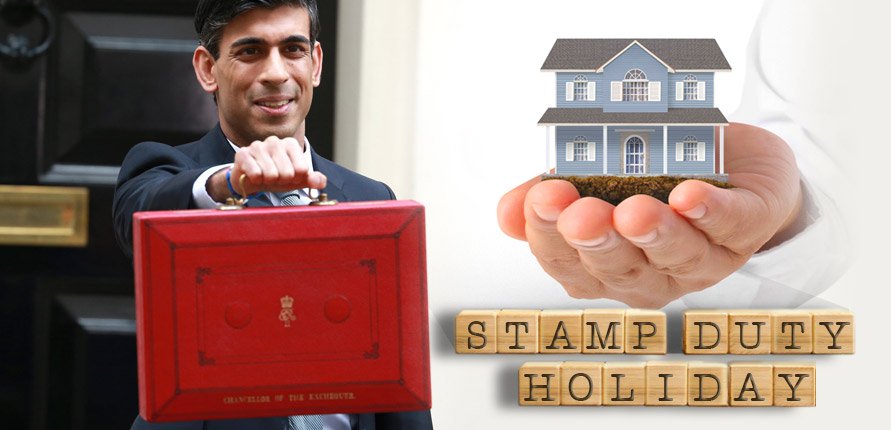
The economy came to an abrupt halt in the wake of coronavirus outbreak, to give it a boost several major announcements were made in the Mini Budget 2020 announced by Chancellor Rishi Sunak in the House of Commons on 8 July 2020. Some important announcements made include cut in the VAT rate, Plan for Work, stamp duty holiday, etc.
The major setback in the economy overall had some inevitable downfall on customer's spending habits. This could more evidently be seen in sectors involving larger spending, as an investment in properties. To specifically boost up the housing market, the government has decided to provide temporary stamp duty holiday so as to incentivize the house buyers.
What is Stamp Duty Land Tax (SDLT)
Stamp Duty Land Tax is a tax demanded to be paid by people buying property or land over a certain price in England and Northern Ireland. The amount of stamp duty that you pay normally depends on several factors, as follows:
- whether you are a first-time buyer or not,
AND
- the value of the property or land.
ALSO, the rate of stamp duty varies if property or land is located in
Scotland or Wales.
How will the temporary stamp duty holiday work?
The general SDLT threshold was £125,000 for RESIDENTIAL PROPERTIES and £150,000 for NON-RESIDENTIAL LAND and PROPERTIES. In other words, no stamp duty is payable if the value of land or property is less than £125,000 for residential property and £150,000 for non-residential property.
With effect from 8 July 2020 till 31 March 2021, the SDLT threshold for RESIDENTIAL PROPERTY has been changed- from £125,000 to £500,000.
This means no stamp duty will be charged on any residential property bought if its value does not exceed £500,000. The rates apply whether you are buying your first home or have owned property before. With effect from 8 July 2020 following table shall be used to work out the SDLT due:
| Property or lease premium or transfer value | SDLT rate |
| Up to £500,000 | Zero |
| The next £425,000 (the portion from £500,001 to £925,000) | 5% |
| The next £575,000 (the portion from £925,001 to £1.5 million) | 10% |
| The remaining amount (the portion above £1.5 million) | 12% |
So, if you buy a residential property worth £975,000, then stamp duty on the property will be worked out as below:
- 0% on first £500,000 = £0
- 5% on next £425,000 = £21,250
- 10% on next £50,000 = £5,000
- Total SDLT = £26,250
If we compare with the stamp duty before the announcement on the same residential property worth £975,000, then SDLT is being calculated as follows:
| BEFORE 8 JULY 2020 | 8 JULY 2020 TO 31 MARCH 2021 | ||
|---|---|---|---|
| Threshold | Stamp duty | Threshold | Stamp duty |
| 0% on first £125,000 | 0 | 0% on first £500,000 | £0 |
| 2% on next £125,000 | 2,500 | 5% on next £425,000 | £21,250 |
| 5% on next £675,000 | 33,750 | 10% on final £50,000 | £5,000 |
| 10% on final £50,000 | 5000 | Total SDLT | £26,250 |
| Total SDLT | 41250 | ||
Thus, from the above example, we see that there is a saving of 15,000.
You can use the HMRC’s SDLT calculator to work out how much stamp duty you’ll pay.
Period of change
The change in the threshold became effective from 8 July 2020 itself and shall remain the same till 31 March 2021.
Additional property
For the buyers, purchasing an additional property between 8 July 2020 to 31 March 2021, a 3% higher rate applies on top of revised standard rates, which is a higher additional stamp duty rate for other properties are as follows:
| Property or lease premium or transfer value | SDLT rate |
| Up to £500,000 | Zero |
| The next £425,000 (the portion from £500,001 to £925,000) | 5% |
| The next £575,000 (the portion from £925,001 to £1.5 million) | 10% |
| The remaining amount (the portion above £1.5 million) | 12% |
New leasehold sales and transfers
The nil rate band which applies to the ‘net present value’ of any rents payable for residential property has also increased to £500,000 from 8 July 2020 until 31 March 2021.
The following rates will apply:
| Net Present Value of any Rent | SDLT rate |
| Up to £500,000 | Zero |
| Over £500,000 | 1% |
Other changes in the Stamp Duty process
To stop spreading coronavirus, HMRC had temporarily declared the following changes earlier:
- Payment of Stamp Duty is being done electronically using Faster Payment, Bacs, or CHAPS. You can find out more about payment here.
- After you have paid your Stamp Duty you must email details like payment reference, payment amount, and date of payment to HMRC at stampdutymailbox@hmrc.gov.uk instead of posting them. An electronic copy/ scanned version of the signed and dated stock transfer form or instrument of transfer or form SH03 can be emailed to HMRC to notify it of a company's purchase of its own shares. HMRC will accept e-signatures on forms or instruments while the coronavirus measures are in place.
A Sigh of Relief
The stamp duty cut has been welcomed by the property professionals. The change is expected to benefit 90% of property buyers, helping each of them save approximately £4,500 on average.












